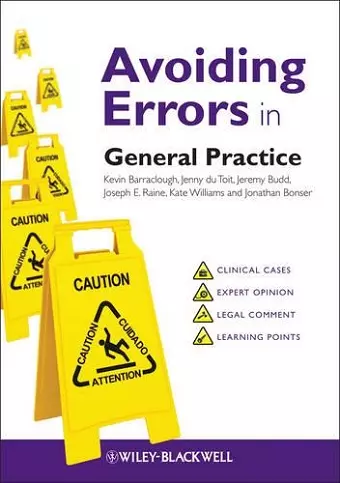Avoiding Errors in General Practice
Essential strategies for managing medical errors in practice
Kate Williams author Kevin Barraclough author Jenny du Toit author Jeremy Budd author Joseph E Raine author Jonathan Bonser author
Format:Paperback
Publisher:John Wiley and Sons Ltd
Published:25th Jan '13
Currently unavailable, and unfortunately no date known when it will be back

This insightful guide addresses the professional and emotional challenges of general practice, focusing on avoiding common medical errors. Avoiding Errors in General Practice is essential for trainees and practitioners.
For Junior Doctors, GP Trainees, and those involved in practice governance, Avoiding Errors in General Practice serves as a comprehensive guide to navigating the professional and emotional challenges faced in the field. This book stands out from other clinical management resources by focusing on the most common and significant medical errors that can occur in an outpatient setting. Recognizing that some of the most valuable lessons in a doctor's career arise from mistakes, it emphasizes the importance of understanding the roots of these errors and fostering positive behaviors to minimize risks and potential litigation.
The structure of Avoiding Errors in General Practice is designed to provide practical insights. The first section delves into the causes of errors, laying a solid foundation for the reader. The second and most extensive section presents case scenarios that illustrate real-life situations, accompanied by expert and legal commentary. This approach not only highlights critical clinical teaching points but also offers strategies to enhance safer practices throughout one's career. The final section addresses how to manage complaints and the possible medico-legal implications, aiming to alleviate anxiety associated with the aftermath of an error.
This guide is invaluable for Foundation Year doctors, trainees, and consultants alike. By equipping readers with the knowledge and tools to avoid common pitfalls, Avoiding Errors in General Practice aims to foster a safer and more confident approach to general practice, ultimately enhancing patient care and professional satisfaction.
“My experience as an expert witness in clinical negligence cases, MPTS Panel chairman, medical adviser to a Public Inquiry and as a sometimes commissioned independent reporter on adverse incidents tells me that these are excellent books, valuable for all clinicians, not just those in high-risk specialties; and all NHS managers involved in maintaining or improving the quality of care. The case vignettes, alone, are useful source material for teaching medical trainees on what can go wrong and how to deal with it when it does.” (Harvey Marcovitch, Clinical Risk journal)
“This is a tremendous exercise in critical thinking skills, i.e. the ability to think through differential diagnoses and longer-term consequences beyond the simple facts presented. This book has great learning value for young and midcareer clinicians to help them hone their diagnostic skills.” (Doody’s, 5 July2013)
"This excellent 182-page book is designed for general practitioners in their early years. It will be a very useful source for all involved in teaching and mentoring those in general practice, and should, I think, be compulsory reading for all practice managers. It is so packed with information, concepts and case studies written in decent English that I found it difficult to put down.
The first section gives a resume of the law concerning breach of medical duty, including the Bolam test. Causation, damages and time limits for litigation are discussed. Protocols, guidelines and communications are considered followed by a heart felt appeal to learn from system failures. This is what I want practice managers to read.
The next section looks at how an initial diagnosis is reached, and then refined. Avoiding being misled by first impressions by testing against a differential diagnosis, excluding diagnoses that must not be missed, considering non-fitting facts, and follow up review all help. Making arrangements to review the case if the illness does not follow the expected course can retrieve the situation, and a record of this can save a reputation.
Communication is recognised as the core of safe practice. I like the simple concept “Ask yourself whether a colleague could work out from your notes the essential details of the consultation.”
Then follows the real meat of the book. This consists of forty recent clinical cases, each demonstrating a particular mishap. These forty cases bring up 95% of causes of complaints against general practitioners. Each describes a case in a few well-chosen sentences, and asks the reader what they think, and might do next. For example, make a differential diagnosis, or perform further simple examinations. An expert opinion is then given on what good practice would involve. This is followed by a legal opinion of the case, including the likely range of damages or settlement. Some of the sums are unnerving! Each case takes up just two pages.
The book ends with the various enquiries and courts that may be faced, and practical advice on addressing them.
I sincerely hope that other practitioners and practice managers will find this little book as thought provoking as I have." (Daniel Haines, FRCGP, MFFLM.)
ISBN: 9780470673577
Dimensions: 244mm x 173mm x 9mm
Weight: 399g
208 pages